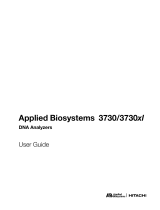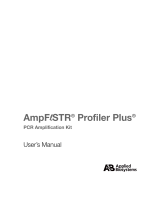Page is loading ...

User Bulletin
ABI PRISM® 310 Genetic Analyzer
01/2007
SUBJECT: Syringe Care and Maintenance
Overview This user bulletin describes the care, use, and maintenance of the syringes used with
the ABI PRISM® 310 Genetic Analyzer.
This information applies to the syringes manufactured by the Kloehn company.
Following the simple care, use, and maintenance tips in this bulletin will ensure
maximum syringe life and satisfactory results with normal use.
We recommend storing this user bulletin in the ABI PRISM® 310 Genetic Analyzer
User’s Manual (PN 903565 or 4317588).
Safety
Information
For safety information, see the ABI PRISM® 310 Genetic Analyzer User’s Manual
(PN 903565 or 4317588).
Warranty
Information
• Each syringe is manufactured to exact tolerances and is tested with deionized
water.
• Warranty replacement policy states that syringes will be replaced free of charge
if a problem occurs within the first 3 months (90 days) of use.
• The lifetime of each syringe varies with use and care.
In this User
Bulletin
This user bulletin includes the following topics:
Topic See page
Syringe Components 2
Liquid Transfer Technique 2
Cleaning the Syringe 3
Handling and Storage 4

2User Bulletin ABI Prism® 310 Genetic Analyzer
Syringe Care and Maintenance
Syringe Components
The Basic
Components
The elements of the syringe discussed in this user bulletin are shown below.
Liquid Transfer Technique
Filling Syringes CHEMICAL HAZARD. POP-4™ and POP-6™ polymer
causes eye, skin, and respiratory tract irritation. Read the MSDS, and follow the
handling instructions. Wear appropriate protective eyewear, clothing, and gloves.
Ferrule O-rings Stainless steel hub Plunger Plunger button
Teflon t i p Glass barrel
To fill a syringe:
Step Action
1. Grasp the syringe by the glass barrel and plunger button.
2. Slowly draw 1.0 mL of deionized water into the syringe, then dispense the water
completely into a waste container.
3. Slowly draw 0.15 mL of polymer into the syringe. Raise to eye level. Hold the
syringe tip up, then dispense completely into a lint-free lab tissue. (This ensures
that the deionized water does not dilute the polymer and, if done correctly,
eliminates bubbles from the syringe.)
4. Fill the syringe with polymer, slightly more than desired volume (for example, if you
need 0.5 mL, fill to 0.7 mL).
5. Raise the syringe to eye level, and hold the syringe tip up with graduation scale
outlined against a white background. Tap the glass barrel with your fingernail to
raise air bubbles, and then gently push the bubbles out using the plunger.
6. Move the syringe plunger to the desired volume.
7. Blot the syringe tip with a lint-free lab tissue without drawing any liquid out of the
tip.
8. Hold the syringe by the stainless steel hub, then gently screw the filled syringe into
the gel block (finger-tight only).
Do not hold the glass barrel to screw the syringe into the gel
block. Hold only the stainless steel hub to avoid breakage.

3User Bulletin ABI Prism® 310 Genetic Analyzer
Cleaning the Syringe
Cleaning the Syringe
Cleaning
Syringes
Clean the syringe:
• Before using for the first time
• When the syringe is removed from the instrument as part of routine
maintenance
• When replacing polymer
• If syringe has been stored dry
To clean the syringe:
Step Action
1Fill a clean disposable container (for example, conical tube or plastic beaker) with
room-temperature deionized water.
Submerge the syringe in the water, then slowly draw water into the barrel by pulling
on the plunger.
Stop pulling the plunger just before it releases from the barrel.
IMPORTANT! Draw water into the syringe slowly (count slowly to 5 as you draw
the plunger from the barrel). Do not remove the plunger from the barrel. Do not
move the plunger quickly. Moving quickly can damage the plunger, cause
premature failure, or cause leakage around the plunger.
Discard the water in the empty container or sink (do not discard back into the clean
water container). Repeat this procedure several times to ensure a thorough flush.
2Remove the ferrule from the syringe.
Soak the ferrule in room-temperature deionized water for as long as it takes to
remove crystals (if any) in the ferrule.
Rinse the ferrule with deionized water.
3Clean the outside of the glass barrel with deionized water, then dry with a lint free
lab wipe.
4Inspect the O-ring in the stainless steel hub of the syringe for damage, and replace
it if necessary.
IMPORTANT! Make sure the O-ring does not block the hole in the stainless steel
hub.
5Place the ferrule back onto the syringe.
6When the syringe is clean, do one of the following:
If… Then…
the syringe is to be used thoroughly dry the outside surface, then
fill with polymer as described in “Liquid
Transfer Technique” on page 2.
the syringe is to be stored • thoroughly dry the outside surface of
the syringe.
• allow the syringe to thoroughly dry
on the benchtop before storing in a
sealed container or drawer.

4User Bulletin ABI Prism® 310 Genetic Analyzer
Syringe Care and Maintenance
Handling and Storage
Matched Sets Each syringe is shipped with the plunger installed in the barrel as a matched set to
ensure that the syringes:
• Do not leak
• Have the proper breakaway force
Note: Breakaway force is the pounds of normal force (not psi) needed to start the
plunger in motion.
Removing the plunger from the barrel and interchanging plungers and barrels can
result in:
• Leakage
• Shortened syringe life (breakaway force too high or too low)
• Capillaries not filled completely (breakaway force too high)
Recommenda-
tions
• Do not place O-rings on the syringe plunger. Doing so will alter the syringe
breakaway force and cause improper filling of capillaries.
• Do not rapidly heat or cool an assembled syringe. Doing so will crack the glass
barrel.
• Allow the polymer to reach room temperature before filling the syringe.
• Draw liquid into the syringe slowly (count slowly to 5 as you draw the plunger
from the barrel). Do not move the plunger quickly. Moving quickly can damage
the plunger, cause premature failure, or cause leakage around the plunger.
• Do not remove the plunger from the barrel. If you accidently remove the plunger
from the barrel, lubricate the teflon tip of the plunger with deionized water
before inserting back into the barrel.
• Store syringes:
–Dry
– Away from direct sunlight
– With the plunger in the barrel
• Use only room- temperature deionized water to clean the syringe.

5User Bulletin ABI Prism® 310 Genetic Analyzer
Handling and Storage

www.appliedbiosystems.com
Worldwide Sales and Support
Applied Biosystems vast distribution and
service network, composed of highly trained
support and applications personnel,
reaches 150 countries on six continents.
For sales office locations and technical support,
please call our local office or refer to our
Web site at www.appliedbiosystems.com.
Applera is committed to providing the
world’s leading technology and information
for life scientists. Applera Corporation
consists of the Applied Biosystems and
Celera Genomics businesses.
Headquarters
850 Lincoln Centre Drive
Foster City, CA 94404 USA
Phone: +1 650.638.5800
Toll Free (In North America): +1 800.345.5224
Fax: +1 650.638.5884
01/2007
Part Number 4314273 Rev. C
Stock Number 106UB12-03
© Copyright 2007, Applied Biosystems. All rights reserved.
For Research Use Only. Not for use in diagnostic procedures.
Information in this document is subject to change without notice. Applied Biosystems assumes no
responsibility for any errors that may appear in this document.
APPLIED BIOSYSTEMS DISCLAIMS ALL WARRANTIES WITH RESPECT TO THIS DOCUMENT,
EXPRESSED OR IMPLIED, INCLUDING BUT NOT LIMITED TO THOSE OF MERCHANTABILITY
OR FITNESS FOR A PARTICULAR PURPOSE. IN NO EVENT SHALL APPLIED BIOSYSTEMS BE
LIABLE, WHETHER IN CONTRACT, TORT, WARRANTY, OR UNDER ANY STATUTE OR ON ANY
OTHER BASIS FOR SPECIAL, INCIDENTAL, INDIRECT, PUNITIVE, MULTIPLE OR
CONSEQUENTIAL DAMAGES IN CONNECTION WITH OR ARISING FROM THIS DOCUMENT,
INCLUDING BUT NOT LIMITED TO THE USE THEREOF.
TRADEMARKS:
Applera, Applied Biosystems, AB (Design) and ABI PRISM are registered trademarks and POP-4
and POP-6 are trademarks of Applera Corporation or its subsidiaries in the US and/or certain other
countries.
All other trademarks are the sole property of their respective owners.
/












